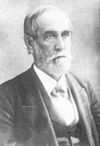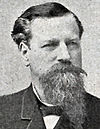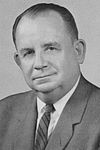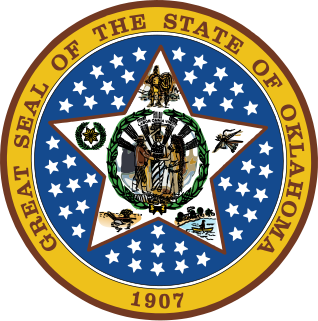It has been requested that the title of this article be changed to List of governors of Missouri . Please see the relevant discussion on the discussion page. The page should not be moved unless the discussion is closed; summarizing the consensus achieved in support of the move. |
| Governor of Missouri | |
|---|---|
 Coat of arms of the state of Missouri | |
| Style | The Honorable |
| Residence | Missouri Governor's Mansion |
| Term length | Four years, renewable once |
| Inaugural holder | Alexander McNair |
| Formation | Constitution of Missouri |
| Deputy | Mike Kehoe |
| Salary | $133,820.88 (2017) [1] |
| Website | governor |
Following is a list of Governors of Missouri since its territory became part of the United States.
Contents
- Governors
- Commandant of Louisiana
- Governor of the District of Louisiana
- Governors of Louisiana Territory and Missouri Territory
- Governors of Missouri
- Civil War
- Notes
- Other high offices held
- Living former governors of Missouri
- References
- External links
| Party | Governors |
|---|---|
| Democratic | 38 |
| Republican | 15 |
| Democratic-Republican | 3 |
| Liberal Republican | 1 |
Missouri was part of the Louisiana Purchase, which the United States purchased from France in 1803. In its first year it was part of Louisiana. In 1804 all of the territory above what is modern-day Louisiana was broken off and administered by a governor based in St. Louis, Missouri until statehood.

The Louisiana Purchase was the acquisition of the Louisiana territory of New France by the United States from France in 1803. The U.S. paid fifty million francs ($11,250,000) and a cancellation of debts worth eighteen million francs ($3,750,000) for a total of sixty-eight million francs. The Louisiana territory included land from fifteen present U.S. states and two Canadian provinces. The territory contained land that forms Arkansas, Missouri, Iowa, Oklahoma, Kansas, and Nebraska; the portion of Minnesota west of the Mississippi River; a large portion of North Dakota; a large portion of South Dakota; the northeastern section of New Mexico; the northern portion of Texas; the area of Montana, Wyoming, and Colorado east of the Continental Divide; Louisiana west of the Mississippi River ; and small portions of land within the present Canadian provinces of Alberta and Saskatchewan. Its non-native population was around 60,000 inhabitants, of whom half were African slaves.

France, officially the French Republic, is a country whose territory consists of metropolitan France in Western Europe and several overseas regions and territories. The metropolitan area of France extends from the Mediterranean Sea to the English Channel and the North Sea, and from the Rhine to the Atlantic Ocean. It is bordered by Belgium, Luxembourg and Germany to the northeast, Switzerland and Italy to the east, and Andorra and Spain to the south. The overseas territories include French Guiana in South America and several islands in the Atlantic, Pacific and Indian oceans. The country's 18 integral regions span a combined area of 643,801 square kilometres (248,573 sq mi) and a total population of 67.3 million. France, a sovereign state, is a unitary semi-presidential republic with its capital in Paris, the country's largest city and main cultural and commercial centre. Other major urban areas include Lyon, Marseille, Toulouse, Bordeaux, Lille and Nice.
Prior to the purchase both France and Spain administered the territory in a similar manner. France initially had a commandant in charge of Upper Louisiana. Spain around 1770 began having a lieutenant governor in St. Louis and governor in New Orleans, Louisiana ruling the whole territory. For a list of governors under Spanish and French rule see Louisiana Governor. For a list of lieutenant governors ruling Upper Louisiana under French and Spanish control see List of commandants of the Illinois Country.
Since the state capitol moved to Jefferson City in 1826 the governor has lived on the same block in the Missouri Governor's Mansion a block east of the Missouri State Capitol (although the current mansion is the third one).

The Missouri Governor's Mansion is a historic U.S. residence in Jefferson City, Missouri. It is located at 100 Madison Street. On May 21, 1969, it was added to the U.S. National Register of Historic Places. It is located in the Missouri State Capitol Historic District.

The Missouri State Capitol is the building that houses the legislative and executive branches of the government of the U.S. state of Missouri, as well as the Missouri General Assembly. Located in Jefferson City at 201 West Capitol Avenue, it is the third capitol in the city after the other two were demolished when they were damaged in fires. The domed building, designed by the New York City architectural firm of Tracy and Swartwout, was completed in 1917.
The current governor is Mike Parson, a member of the Republican Party.

Michael L. Parson is an American politician and former law enforcement officer who is the 57th Governor of Missouri, having taken office on June 1, 2018, after the resignation of Eric Greitens. Parson previously had been the 47th Lieutenant Governor of Missouri. Before that, he served as a Republican member of the Missouri House of Representatives from the 133rd district (2005–2011) and as a member of the Missouri Senate representing the 28th district (2011–2017). Parson was the Majority Caucus Whip in the Senate during the 96th General Assembly.

The Republican Party, also referred to as the GOP, is one of the two major political parties in the United States; the other is its historic rival, the Democratic Party.






































































